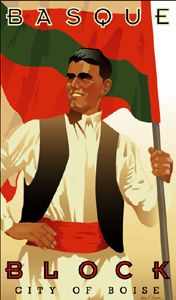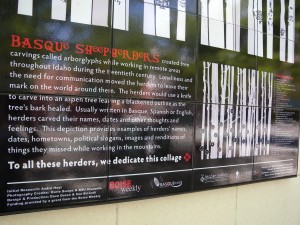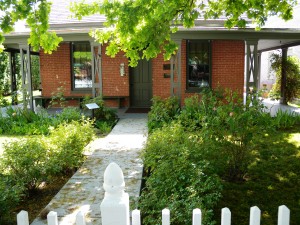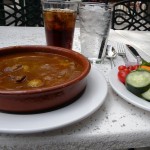» posted on Wednesday, May 16th, 2012 by Linda Lou Burton
Basking on Basque Block
 Linda Burton posting from Boise, Idaho – Oh come on, my pun’s okay; even the Basque Museum posts a window sign that says “Who Is That Basque Man?” Not knowledgeable about Basques in Idaho, I realized I had a lot to learn. I can tell you this – Basque culture is very much alive in Boise; the ethnic community numbers about 15,000 and is the largest such community in the United States (fifth largest in the world, behind Mexico, Argentina, Chile, and of course the Basque Country of Spain and France). But seriously, who is that Basque man? One is the Mayor of Boise, David Bieter, elected in 2003, and in 2007, and in 2011; fluent in Basque and Spanish, he is extensively involved in Boise’s Basque community and in 2005 was awarded the “Basques Throughout The World” award for his work on behalf of Basque peace and self-determination. I wandered the area known as Basque Block, a vibrant downtown section between 6th and Capitol Boulevard on Grove Street, to find out more.
Linda Burton posting from Boise, Idaho – Oh come on, my pun’s okay; even the Basque Museum posts a window sign that says “Who Is That Basque Man?” Not knowledgeable about Basques in Idaho, I realized I had a lot to learn. I can tell you this – Basque culture is very much alive in Boise; the ethnic community numbers about 15,000 and is the largest such community in the United States (fifth largest in the world, behind Mexico, Argentina, Chile, and of course the Basque Country of Spain and France). But seriously, who is that Basque man? One is the Mayor of Boise, David Bieter, elected in 2003, and in 2007, and in 2011; fluent in Basque and Spanish, he is extensively involved in Boise’s Basque community and in 2005 was awarded the “Basques Throughout The World” award for his work on behalf of Basque peace and self-determination. I wandered the area known as Basque Block, a vibrant downtown section between 6th and Capitol Boulevard on Grove Street, to find out more.
The vast majority of Basques living in the Boise area came from the province of Bizkaia in the late 1800’s. Known to be hardworking and honest people, many became sheepherders; some worked in mining and logging. Basque Block seeks to preserves their heritage, and pass it on to new generations. 
The Basque Center, on the corner at 601 Grove, was built in the 1940’s as a social club; it’s still a social gathering place and used today for dance practices – the Oinkari Basque Dancers are age 14+, the Boise’ko Gasteak Dancers are ages 2-13; or you may find older Basques there drinking coffee or playing Mus, a Basque card game. www.basquecenter.com 
The Cyrus Jacobs-Uberuaga Boarding House at 607 Grove was built in 1864, and is the oldest surviving brick building in existence in Boise. It boasted the first indoor bathtub in town and was rented by Basques for use as a boarding house in 1910; the Uberuaga family bought it in 1917 and it continued as a boarding house until 1969. Efforts are underway to restore it so it tells the story of Basque life between 1910-1930. It was designated a Historic Landmark by the Historic Preservation Commission in 2010.
The Basque Museum and Cultural Center at 611 Grove houses interpretive exhibits on the Basques and their history in Idaho; there are classrooms, a library, a genealogy research center, archives of music, dance, photographs, and oral history; and a lovely gift shop. Basque language classes are offered two times a week. www.basquemuseum.com 
The Fronton Building at 619 Grove was built as a boarding house in 1912 and is unique because of the “fronton” or Basque handball court, inside. Although used as office space for almost 50 years, the area where the playing court is located was never modified. The Fronton Association owns it now and hopes to start teaching younger children the traditional Basque games of handball and “pala,” a sport played with a heavy wooden racket and a hard rubber ball.
The block winds up with Gernika, a Basque pub and eatery on the corner at 202 S Capitol. It also is a gathering point; as are the restaurants across the street, outdoor seating draws you in. I chose Leku Ona on the opposite corner at the other end (117 S 6th) for my lunchtime stop; it offers indoor and outdoor dining; a small hotel adjoins. Leku Ona means “Good Place” and indeed I found it pleasant there.  Did I want Leku Ona Ensalada, mixed greens topped with tuna, green olives, tomatoes, white asparagus, and egg? Or baked lamb meatloaf, tomato glazed? I settled for lamb stew, Arkumi Sukalki, diced lamb with peas and carrots and baby potatoes. I don’t favor lamb, but it seemed the thing to do, as I sat beneath the red and green Basque flag. http://www.lekuonaid.com/
Did I want Leku Ona Ensalada, mixed greens topped with tuna, green olives, tomatoes, white asparagus, and egg? Or baked lamb meatloaf, tomato glazed? I settled for lamb stew, Arkumi Sukalki, diced lamb with peas and carrots and baby potatoes. I don’t favor lamb, but it seemed the thing to do, as I sat beneath the red and green Basque flag. http://www.lekuonaid.com/ 
Basque Factoids
- The biggest Basque celebration is based around the religious feast day of Saint Ignatius of Loyola, patron saint of the Basques and founder of the Jesuit religious order; annually on the last weekend in July; music, sports, dances, a picnic.
- The Sheepherder’s Ball has been held since 1929, annually in December.
- Jaialdi, an International festival, is held in Boise every five years, next in 2015, performers and athletes come from Basque Country and all over the US.
- The North American Basque Organization (NABO) was formed in the 1970’s to unite Basque Organizations in the US; it sponsors a Mus card playing tournament, a Music Camp for children, and a handball and pala tournament.
- Boise State University offers a program in Basque Studies. http://sspa.boisestate.edu/basquestudies/community/
- Guernica, the statutory capital of Vizcaya and sacred to the Basques, was heavily bombed by German and Italian warplanes in 1937 during the Spanish Civil War. The destruction from that bombing was the subject of the painting by Picasso named simply, Guernica.
About the Mayor http://www.cityofboise.org/Departments/Mayor/CityCouncil/page934.aspx
About Basque Block http://www.thebasqueblock.com/history.asp
About the Cenarrusa Foundation for Basque Culture http://cenarrusa.org/
